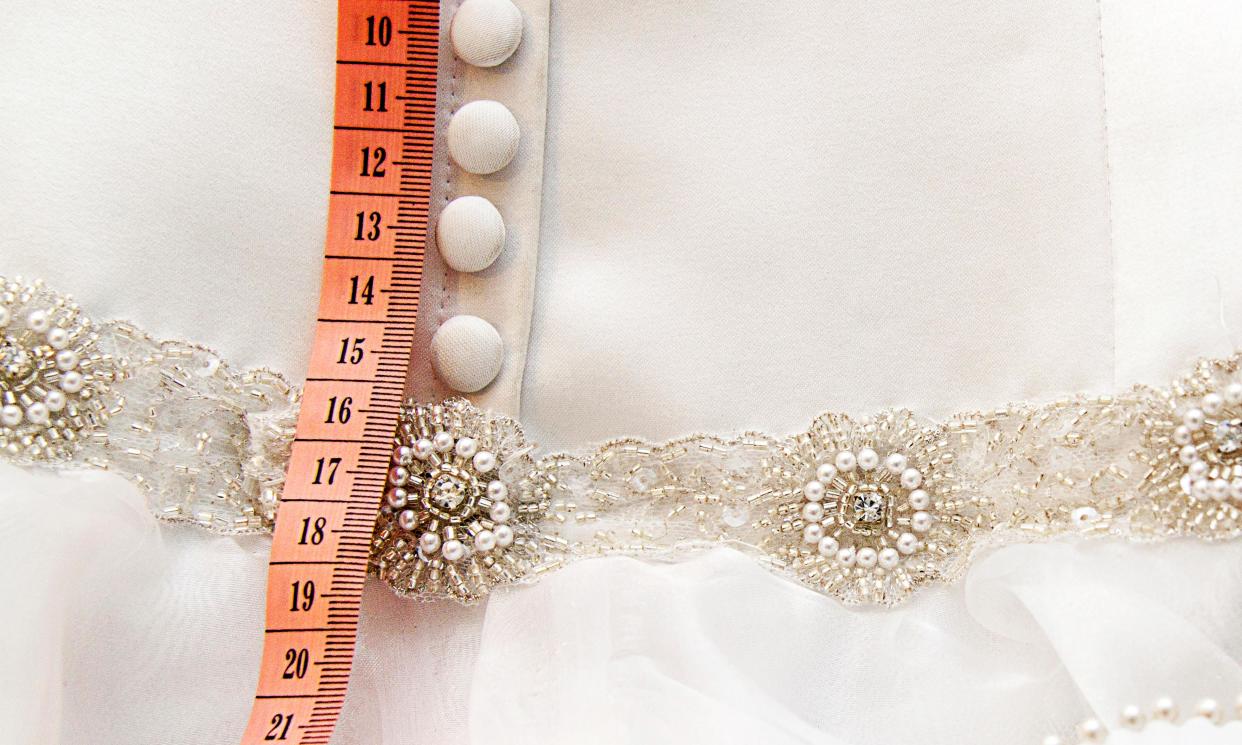Body positivity can come in many forms – even a custom-made wedding dress

The couturier is using her tape measure like a magic wand. The hand, faster than the eye, is calibrating elbow to wrist, circumference of neck, knee to floor. An assured air, a deft movement and voila, the tape measure is up between the legs, shoulder to crotch is noted and the tape is out again before the client even registers.
It’s an intimate process, being measured for a handmade wedding dress. Couturiers become the keepers of secrets, the holders of confidences, the conjurers of dreams. They must be exquisite listeners, tough-love truth-tellers and amateur psychotherapists. They are architects of fabric, aesthetic innovators, geniuses with lace and silk, and most of all they must believe in the sacred commitment of love, one to another.
Related: What gets you hot? The sweaty, brutally honest show about bodies
When the Charles Perkins Centre at the University of Sydney advertised for a writer to work with it, I applied with a pitch to write a play about wedding couturiers and their relationship to clients living in big bodies. I set out across the city of Sydney, interviewing couturiers from a diversity of suburbs, attending bridal fairs and speaking to stall holders, even consulting with some tailors in London.
What I found was a startling similarity in the stories they told me. There was always a bride who had lost a lot of weight before the wedding, making her couturier’s job a nightmare of adjustments. There was always a funny story about a celebrity bride, or the daughter of royalty or riches. There were, astonishingly, several stories about people who were switched at birth at hospitals here or overseas (who knew?). It was always the size 10 clients who wanted to lose weight the most and strapped themselves up in Spanx before fittings; the older clients “sat more stably in their curves”. And because I was talking about love and life and marriage and sex and men and women, there were also many stories about death and grief and rage and betrayal.
When I came to write all this up I chose to make Monica, the couturier character in my play, Made to Measure, entirely fictional. Although I have, with permission, included stories from a number of couturiers, the character onstage is not based on, nor meant to represent or resemble, any living person.
Likewise, Ashleigh, the client character in the play, is informed by but not drawn exclusively from any one source; rather, she is an amalgam of clients, acquaintances, and friends who are living their lives in large bodies. They told me stories that were sometimes brutal and ruthless, based on comments that had been made to them by others and, most sobering of all, by things they had thought or felt about themselves.
The one thing I was told over and over, especially by those who are subject to weight-bias discrimination, is that the worst thing I could do was to dumb down or sugar-coat what people living in large bodies are exposed to, or can internalise into vicious inner voices. It has been sometimes harrowing to put on stage the true extent of misunderstanding and vitriol that is visited upon people living in large bodies, but to a person they told me: “Don’t nice it up, don’t wimp out. Make it as savage as it is for us.”
Related: 'I have the right to tell this story': Lukas Dhont defends his trans film Girl
Made to Measure seeks to affirm the perspectives of body positivity activists as well as nutrition scientists. It is an attempt to walk into the maelstrom of debate and produce out of it a work of art that underlines the complexity of these issues as they relate to credible characters. I learnt that there are as many different perspectives as there are people living in large bodies. But, encouragingly, 20th century body shame and weight bias is ever so slowly but surely being eroded by this terrific new generation of young women and men.
Every single couturier I spoke to was a romantic who believed that one person saying “I love you” to another could, if not save the world, at least bring a little more beauty and joy into it. For them, an original dress or suit is not about vanity or Instagram likes– it is about taking the time to manifest, on the body, the individuality of each and every person, and to show that distinction, with pride.
Take the time. Add it to your bucket list. Get a dress, a shirt, a skirt, a coat, a suit made to measure by a dressmaker or tailor. It’s a pleasure that every individual body should experience at least once in their life.
• Made to Measure is showing at the Seymour Centre, Sydney,
• Alana Valentine is an Australian playwright

 Yahoo News
Yahoo News 
